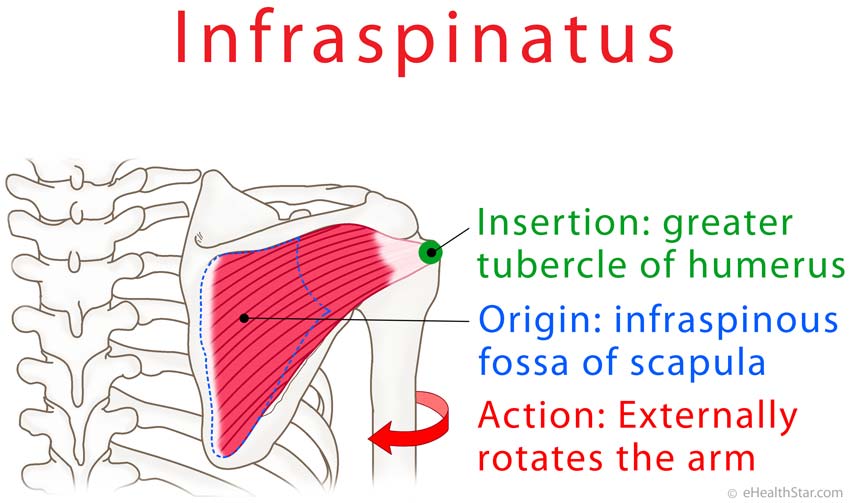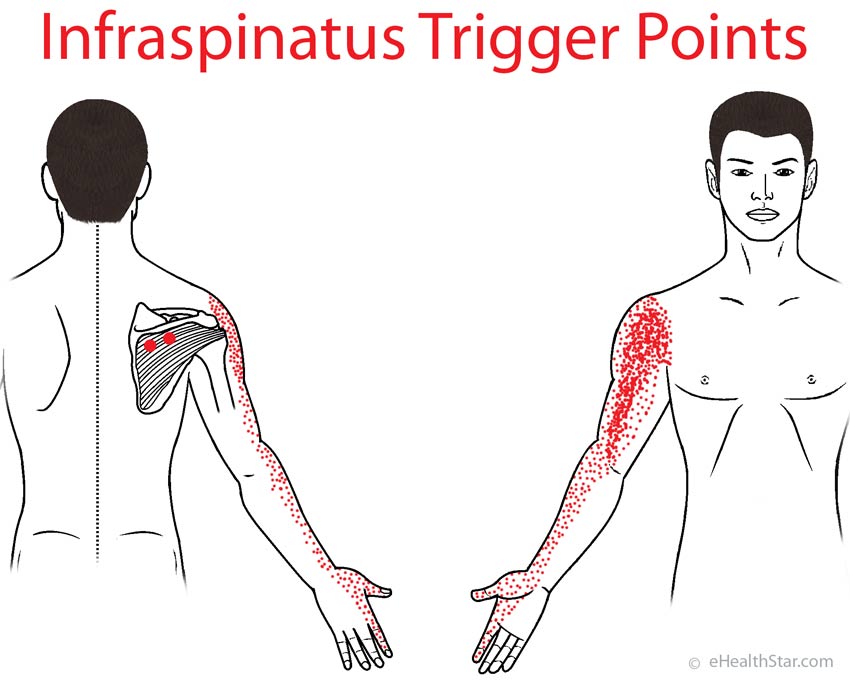Infraspinatus Location
The infraspinatus is one of the 4 rotator cuff muscles that embrace the shoulder joint (the other 3 being supraspinatus, teres minor and subscapularis). It extends from the lower back surface of the shoulder blade (scapula) to the upper part of the upper arm bone (humerus).
Origin
The infraspinatus originates from the infraspinatus fossa of the scapula [1].
Insertion
The infraspinatus inserts to the middle part of the greater tubercle of the humerus [1].
Functions (Actions)
- Externally (laterally) rotates the arm in the shoulder joint
- Assists in raising an arm sideways (abduction), such as during brushing hair
- Stabilizes the humeral head in the shoulder joint
- Reference: [1]
Innervation
The infraspinatus is innervated by the supraspinatus nerve that arises from the spinal nerve roots C5 and C6 [1].
Blood Supply
The infraspinatus gets the blood via the suprascapular and circumflex scapular arteries [2].
Picture 1. The infraspinatus muscle anatomy (back view)
Related anatomy:
Infraspinatus Myofascial Pain, Strain, Tear and Atrophy
Myofascial pain is chronic pain that arises from the muscle sheath called fascia and is caused by prolonged muscle overload, for example, due to prolonged computer work with no elbow support, driving with hands on the top of the steering wheel, walking a strong pulling dog or carrying heavy objects.
Infraspinatus strain or tear can occur during sports that include reaching back with a hand, such as tennis or baseball, or even when pulling off the shirt or throwing something into the back of your car.
Infraspinatus atrophy (muscle wasting) can result from a muscle tear or damage (neuropathy) of the suprascapular nerve, mainly in athletes with frequent overhead activities (baseball, volleyball, tennis) [5].
Symptoms and signs:
- Deep pain in the front of the shoulder joint and, sometimes, down the outer side of an arm
- Difficulty pushing objects or opening the door
- Difficulty reaching backward
- Difficulty sleeping on the affected side
- Applying pressure on the trigger points can cause pain that radiates down the outer side of the arm toward the thumb and index finger.
- With time, untreated tear can result in muscle wasting (atrophy) with a visible depression below the spine of the scapula [4]
Picture 2. Infraspinatus muscle trigger points
(2 red dots over the scapula in the left image)
and pain distribution
Infraspinatus Pain Test
Test 1: Painful arc test. While standing, raise an extended arm on the affected side sideways all the way up. If you feel pain in the shoulder or upper arm when your arm is raised between 70 and 110 degrees but not before or after that, it means your infraspinatus tendon is probably affected.
Test 2: Resisted lateral rotation. While standing with your affected arm hanging freely down, bend your elbow, so your forearm will point forward. While an examiner holds your forearm, try to move your forearm sideways against the examiner’s arm (Video 1). The pain in the shoulder and weakness when moving your arm speak for the infraspinatus injury.
Video 1. Infraspinatus pain test
A doctor can make a diagnosis of an infraspinatus tear from symptoms and tests alone. The tear can be detected by arthroscopy, ultrasound, magnetic resonance imaging (MRI), but not by an X-ray.
Differential Diagnosis
Other conditions that can cause the pain in the front of the shoulder:
- Inflammation or tear of other rotator cuff muscles (supraspinatus, teres minor, subscapularis)
- Tendonitis of the biceps tendon
- Shoulder joint conditions: arthritis, adhesive capsulitis, shoulder sprain
- Herniated disc in the neck
- Thoracic outlet syndrome
Treatment
Treatment of infraspinatus myofascial pain includes massage with a tennis or lacrosse ball against a wall or myofascial release — a massage of trigger points performed by a physiotherapist.
Treatment of infraspinatus tear can include [3]:
- Rest from the activities that cause pain (2-3 months or longer)
- Friction massage for 4-6 weeks, which prevents adhesions
- Exercise therapy every day for 6-8 weeks
Exercise
In a strained/ruptured infraspinatus, exercises should be performed only to the point of pain.
Shoulder adduction [3]. While standing, raise your arm on the affected side forward, so your elbow will be at the level of the shoulder and your forearm will point upwards. Grab the elbow with the other hand and pull it toward the opposite shoulder. Sustain for 30 seconds, release and repeat 5 times.
Video 2. Infraspinatus muscle anatomy and myofascial pain distribution
Key Points
- To prevent infraspinatus myofascial pain, avoid carrying heavy bags and prolonged elevation of the arms without the elbow support. Stretch your shoulder muscles well before sports activities.
- To enable proper healing of a ruptured infraspinatus, rest from the painful activities as long as needed and ask a physiotherapist to show you therapeutic exercises.
- References
- Infraspinatus muscle GetBodySmart
- Infraspinatus University of Washington, Department of Radiology
- Benjamin B, 2004, Shoulder Series #1: Infraspinatus Tendinitis Massagetherapy.com
- Yao L et al, Infraspinatus muscle atrophy: implications? PubMed
- Trojian TH, Suprascapular neuropathy, overview Emedicine



